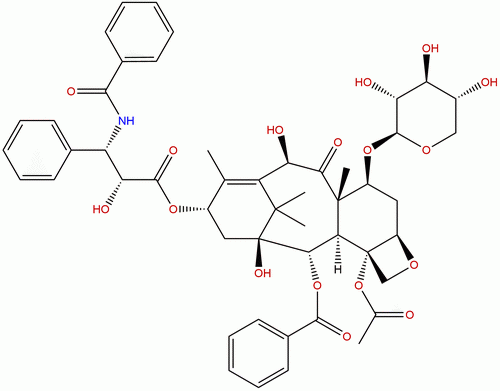
10-Deacetyl-7-xylosyl paclitaxelCAS No.:90332-63-1
|
||||||||||
 |
|
|
||||||||

| Catalogue No.: | SBP03710 |
| Formula: | C50H57NO17 |
| Mol Weight: | 943.996 |
Product name: 10-Deacetyl-7-xylosyl paclitaxel
Synonym name:
Catalogue No.: SBP03710
Cas No.: 90332-63-1
Formula: C50H57NO17
Mol Weight: 943.996
Botanical Source:
Physical Description:
Type of Compound: Diterpenoids
Purity: 95%~99%
Analysis Method: HPLC-DAD or/and HPLC-ELSD
Identification Method: Mass, NMR
Packing: Brown vial or HDPE plastic bottle
The product could be supplied from milligrams to grams
Inquire for bulk scale.
For Reference Standard and R&D, Not for Human Use Directly.
Description:
10-Deacetyl-7-xylosyl paclitaxel has long been used in Chinese clinics to treat cancer, it may target mitochondrial permeability transition pore (mPTP).
References:
Planta Med. 2010 Oct;76(14):1592-5.
Transport of a hydrophilic paclitaxel derivative, 7-xylosyl-10-deacetylpaclitaxel, by human intestinal epithelial Caco-2 cells.
7-Xylosyl-10-deacetylpaclitaxel(10-Deacetyl-7-xylosyl paclitaxel) is an active compound used in traditional Chinese medicine to treat cancer. However, pharmacokinetic studies yielded low plasma concentrations of 7-xylosyl-10-deacetylpaclitaxel after its oral administration in preclinical trials. Therefore, we investigated whether the observed low oral bioavailability of this compound is due to poor absorption.
METHODS AND RESULTS:
We studied the transepithelial flux of 7-xylosyl-10-deacetylpaclitaxel using the human colonic cell line Caco-2 as a model and found out that its flux (at a concentration range of 0.5-20 μM) across the Caco-2 cell layer was linear with time for up to 3 hr. The apparent maximal concentration (K (M)) of the active efflux component was 93.4 μM. Verapamil (50 μM) and tetrandrine (25 μM) significantly decreased the active transport component.
CONCLUSIONS:
These data support the conclusion that rapid passive diffusion of 7-xylosyl-10-deacetylpaclitaxel through the intestinal epithelium is partially counteracted by the action of an outwardly directed efflux pump, presumably P-glycoprotein. The relatively high apparent permeability coefficient ( P(app)) for the apical to basolateral 7-xylosyl-10-deacetylpaclitaxel transport (16.3 ± 6.3 × 10 (-6) cm/s; n = 3) suggests that the drug may still be effectively absorbed in the intestinal tract.